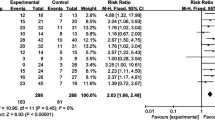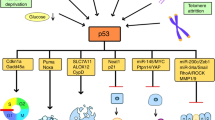Abstract
The objective of this study was to determine if a combination of recombinant adenovirus 2 p53 (rAd2p53) gene therapy and radiotherapy would have significantly improved outcome from esophageal carcinoma when compared to radiotherapy (RT) alone. Forty-five patients diagnosed with esophageal carcinoma (confirmed squamous cell carcinoma) were randomly assigned to one of two study arms: treatment group: rAd2p53 gene therapy + RT (n = 22); and control group: radiotherapy (n = 23). For the treatment group, rAd2p53 was injected into multiple areas of the lesion once a week for 6 weeks avoiding deep ulcers points. RT was administered after 3 days of injection of rAd2p53. Patients in the control group only received radiotherapy. The overall response rate was significantly higher in the treatment group than in control group (P < 0.05). Furthermore, the complete response rate was 3 times higher in the treatment group than in the control group (P < 0.05). Transient fever and pain at injection site were the only side effects mentioned in the treatment group. In conclusion, this recombinant virus–RT combination is significantly more beneficial in palliation than RT alone, with minor side affects. However, its role as neoadjuvant therapy prior to surgical resection needs to be further investigated.




Similar content being viewed by others
References
Yu, J. Y. W.-b., & Li, B.-S. (2007). Precision radiotherapy of cancer. Shandong Science and Technology Press, 3, 392–721.
Cooper, J. S., Guo, M. D., Herskovic, A., Macdonald, J. S., Martenson, J. A., Jr., Al-Sarraf, M., et al. (1999). Chemoradiotherapy of locally advanced esophageal cancer: Long-term follow-up of a prospective randomized trial (RTOG 85–01). Radiation Therapy Oncology Group. JAMA, 281, 1623–1627.
Koshy, M., Esiashvilli, N., Landry, J. C., Thomas, C. R., Jr., & Matthews, R. H. (2004). Multiple management modalities in esophageal cancer: Combined modality management approaches. Oncologist, 9, 147–159.
Swisher, S. G., Ajani, J. A., Komaki, R., Nesbitt, J. C., Correa, A. M., Cox, J. D., et al. (2003). Long-term outcome of phase II trial evaluating chemotherapy, chemoradiotherapy, and surgery for locoregionally advanced esophageal cancer. International Journal of Radiation Oncology, Biology, Physics, 57, 120–127.
Yin, W. (2006). Development of radiation treatment of esophageal cancer. Journal of Practical Oncology, 21, 99–103.
Cook, T., Wang, Z., Alber, S., Liu, K., Watkins, S. C., Vodovotz, Y., et al. (2004). Nitric oxide and ionizing radiation synergistically promote apoptosis and growth inhibition of cancer by activating p53. Cancer Research, 64, 8015–8021.
Kunisaki, R., Ikawa, S., Maeda, T., Nakazaki, Y., Kurita, R., Harata, M., et al. (2006). p51/p63, a novel p53 homologue, potentiates p53 activity and is a human cancer gene therapy candidate. The Journal of Gene Medicine, 8, 1121–1130.
Swisher, S. G., Roth, J. A., Komaki, R., Gu, J., Lee, J. J., Hicks, M., et al. (2003). Induction of p53-regulated genes and tumor regression in lung cancer patients after intratumoral delivery of adenoviral p53 (INGN 201) and radiation therapy. Clinical Cancer Research, 9, 93–101.
Anderson, S. C., Johnson, D. E., Harris, M. P., Engler, H., Hancock, W., Huang, W. M., et al. (1998). p53 gene therapy in a rat model of hepatocellular carcinoma: Intra-arterial delivery of a recombinant adenovirus. Clinical Cancer Research, 4, 1649–1659.
Hofseth, L. J., Hussain, S. P., & Harris, C. C. (2004). p53: 25 years after its discovery. Trends in Pharmacological Sciences, 25, 177–181.
Chen, C., Pan, J., & Xu, L. (2003). Recombinant adenovirus p53 agent injection combined with radiotherapy in treatment of nasopharyngeal carcinoma: A phase II clinical trial. Zhonghua Yi Xue Za Zhi, 83, 2033–2035.
Yunqing, Z., & Li, X. (2002). The significance of the expression of P53 and p21 in esophageal cancer and nasopharyngeal cancer. Henan Journal of Oncology, 15, 287–288.
Tsuda, H., Sata, M., Ijuuin, H., Kumabe, T., Uchida, M., Ogou, Y., et al. (2002). A novel strategy for remission induction and maintenance in cancer therapy. Oncology Reports, 9, 65–68.
Jain, P. T., & Gewirtz, D. A. (1999). Sustained enhancement of liposome-mediated gene delivery and gene expression in human breast tumour cells by ionizing radiation. International Journal of Radiation Biology, 75, 217–223.
Roth, J. A., Swisher, S. G., & Meyn, R. E. (1999). p53 tumor suppressor gene therapy for cancer. Oncology (Williston Park), 13, 148–154.
Shimada, H., Matsubara, H., & Ochiai, T. (2002). Gene therapy for esophageal cancer. Nippon Geka Gakkai Zasshi, 103, 371–375.
Shimada, H., Shimizu, T., Ochiai, T., Liu, T. L., Sashiyama, H., Nakamura, A., et al. (2001). Preclinical study of adenoviral p53 gene therapy for esophageal cancer. Surgery Today, 31, 597–604.
Shimada, H., Matsubara, H., Shiratori, T., Shimizu, T., Miyazaki, S., Okazumi, S., et al. (2006). Phase I/II adenoviral p53 gene therapy for chemoradiation resistant advanced esophageal squamous cell carcinoma. Cancer Science, 97, 554–561.
Lixin, Z., Limin, H., & Weizhen, Z. (2004). Synchronic radiotherapy-chemotherapy compared with radiotherapy alone in patients with upper and middle esophageal cancer. Tumor, 24, 303–304.
Acknowledgments
We thank Drs Lu Yao and Lei Tang for their guidance and support. We also thank Ms Bing for her excellent assistance in patient data analyses. This work was supported in part by Grant from the Ministry of Education, Culture, Sports, Science and Technology of China.
Author information
Authors and Affiliations
Corresponding author
Rights and permissions
About this article
Cite this article
Lu, P., Yang, X., Huang, Y. et al. Antitumor Activity of a Combination of rAd2p53 Adenoviral Gene Therapy and Radiotherapy in Esophageal Carcinoma. Cell Biochem Biophys 59, 147–152 (2011). https://doi.org/10.1007/s12013-010-9122-z
Published:
Issue Date:
DOI: https://doi.org/10.1007/s12013-010-9122-z




